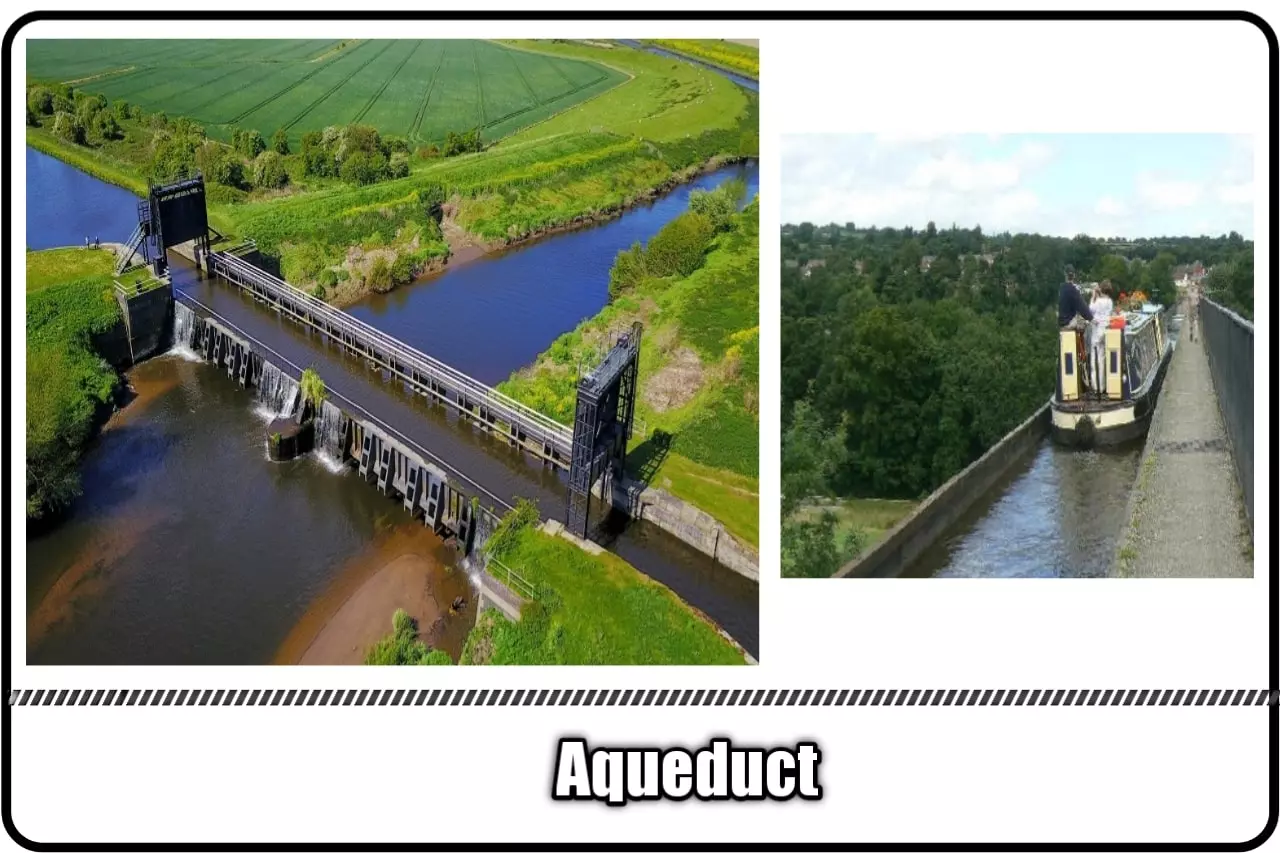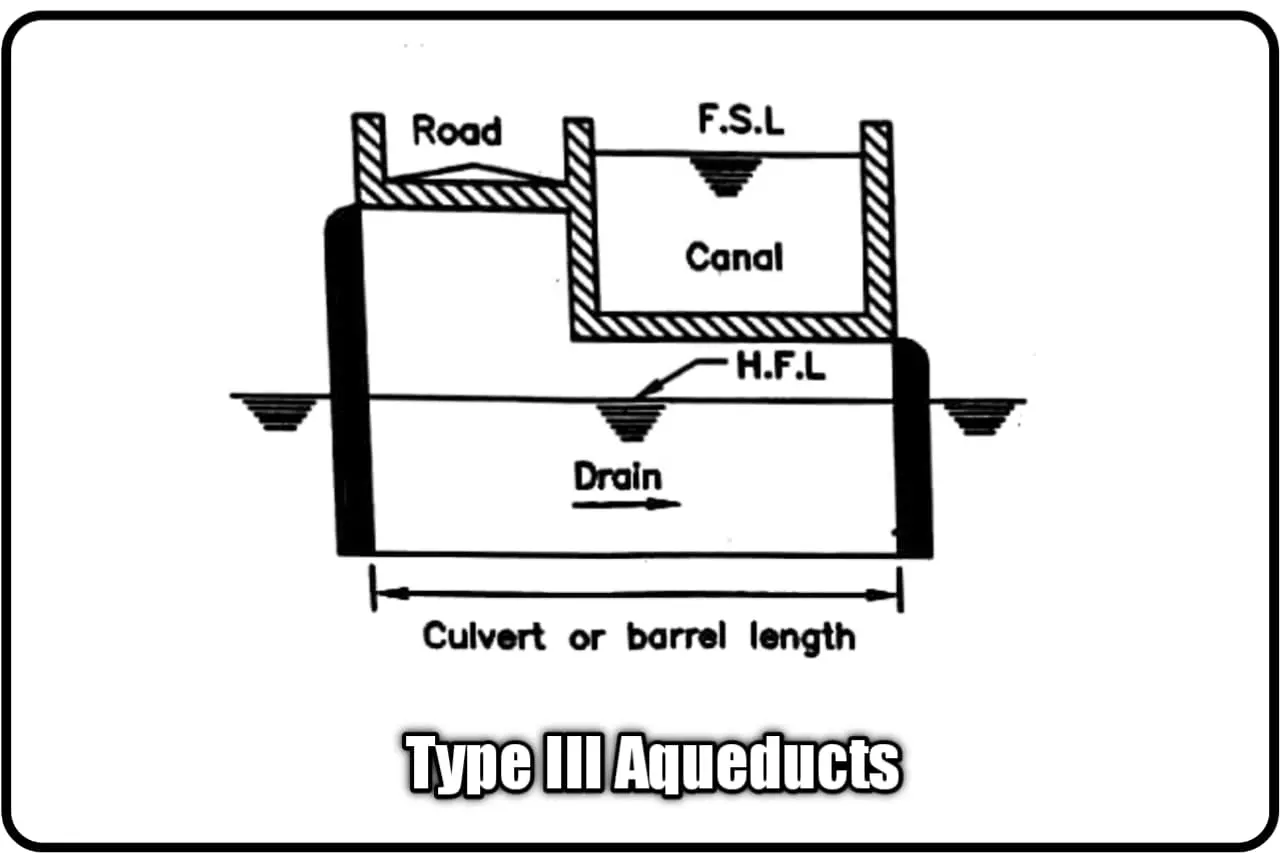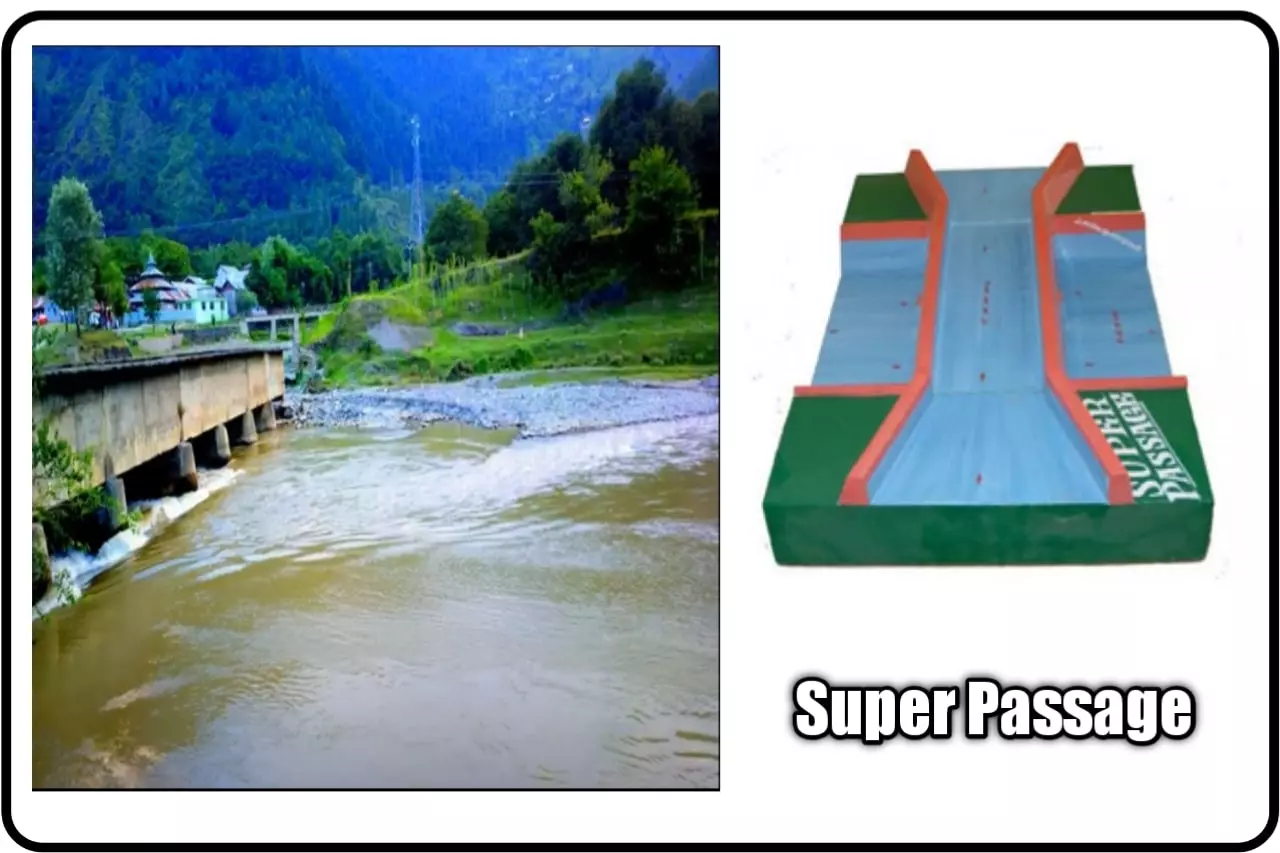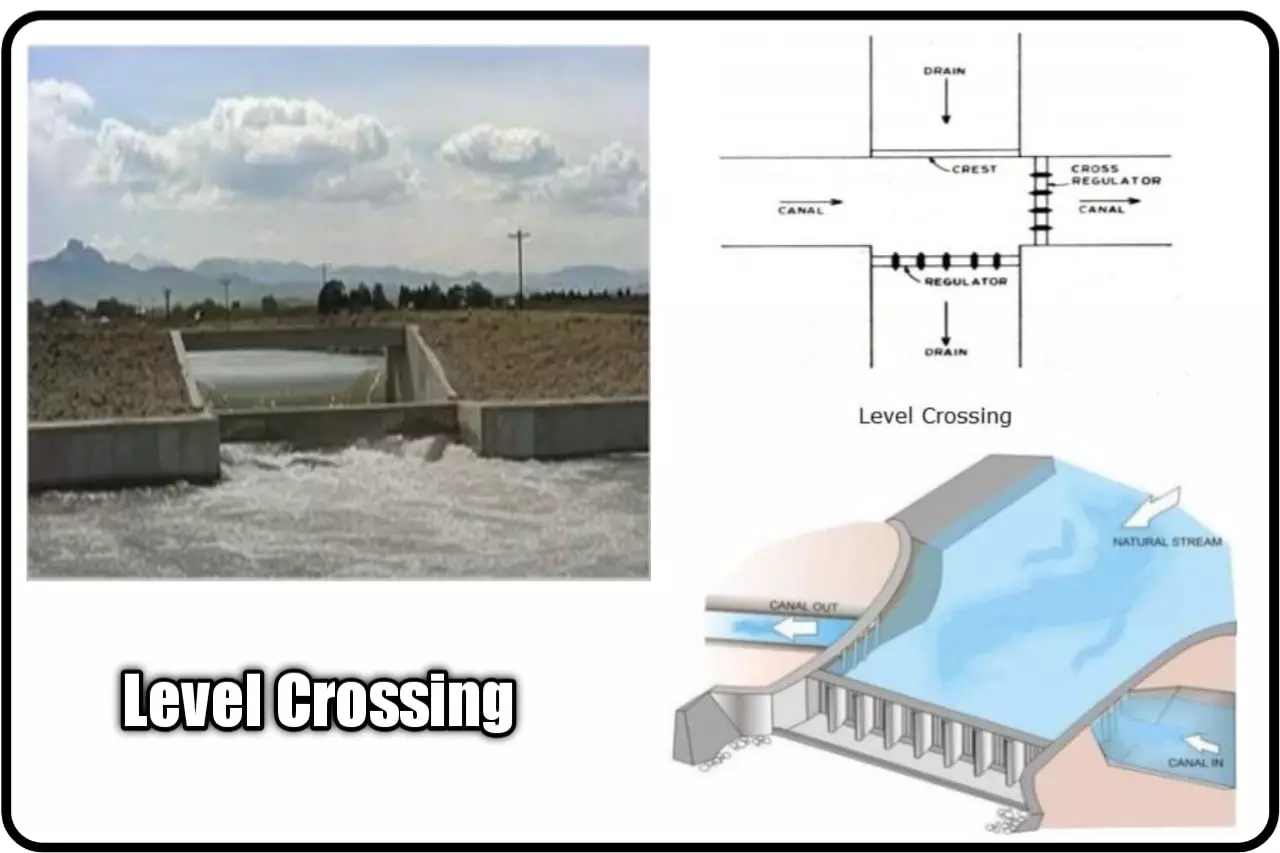Hello All, In this article we will see all types of cross drainage works used widely in India. Before we go into detail on types of cross drainage works let’s first see what is cross drainage works?
What Is Cross Drainage Work?
A cross drainage work is a structure constructed for carrying a canal across a natural drain or river intercepting the canal.
In order to minimize the number of cross drainage works, canals are generally aligned on a watershed so that they intercept a minimum number of natural drains. However, a canal taking off from a river requires a certain distance before it can mount the watershed. Once the canal is taken to the watershed, no cross drainage works are normally required. However, when the canal is aligned as a contour canal, a number of cross drainage works are necessary.

A cross drainage work is an expensive structure and should be avoided as far as possible. The number of cross drainage works can be reduced by
(i) Changing the alignment of the canal.
(ii) Diverting small drainages into large drainages.
Types of cross drainage works
Depending upon the relative bed levels and discharges, types of cross drainage works are given below.
(A) Cross Drainage Works Carrying Canal Over The Natural Drain :
- Aqueduct
- Syphon Aqueduct
(B) Cross Drainage Works Carrying The Natural Drain Over The Canal :
- Super Passage
- Canal Syphon
(C) Cross Drainage Works Admitting The Drain Water Into The Canal :
- Level Crossing
- Inlets And Outlets
Lets Discuss step by step all types of cross drainage works which are widely used in India.
(A) CROSS DRAINAGE WORKS CARRYING THE CANAL OVER THE NATURAL DRAIN :
In these types of cross drainage works, the canal is carried over the natural drain. The advantage of such an arrangement is that the canal running perennially is above the ground level and is open to inspection. Also, the damage due to floods is rare.
The structures that fall under this type are :
- Aqueduct
- Syphon aqueduct
1. Aqueduct :
An aqueduct is a structure in which the canal flows over the drain (i.e. river) and the bed of the canal is well above the H.F.L. of the drain. The canal water is taken across the drain in a trough supported on piers.

The drain water flows under the canal such that there is sufficient headway available between the H.F.L. of the drain and underside of the canal trough. The drain water flows at atmospheric pressure under the canal.
2. Syphon Aqueduct :
A syphon aqueduct is also a structure in which the canal flows over the drain (i.e. river) but the H.F.L. of the drain is higher than the canal bed. The drain water flows under syphonic action through the aqueduct barrels.
When sufficient level difference is not available between the canal bed and the H.F.L. of the drain to pass the drainage water, the bed of the drainage may be depressed below its normal bed level.

The drain is provided with an impervious floor at the crossing and thus a barrel is formed between the piers to pass the drainage water under pressure. These barrels actually form an inverted syphon and not syphon.
Classification of aqueducts and syphon aqueducts :

Depending upon the nature of the sides, aqueducts or siphon aqueducts are classified as under :
TYPE I :
In this type, the sides of the aqueduct (or siphon aqueduct) are in earthen banks with complete earthen slopes. The original canal section is retained and no flaming is done.

TYPE II :
In this type also the canal continues in its earthen section over the drain, but the outer slopes of the earthen banks are replaced by retaining walls, thereby reducing the length of the barrels to that extent.

TYPE III :
In this type, the earthen banks are not provided through the. aqueduct, fuming is done, and canal water is carried in a concrete trough. The sides of the trough are connected on either side of the work to earthen banks of the canal through wing walls. Thus in this case the length of. drain barrels are reduced.

(B) CROSS DRAINAGE WORKS CARRYING THE NATURAL DRAIN OVER THE CANAL :
In these types of cross drainage works the natural drain Is carried over the canal. The advantage of this type is that the C.D. works themselves are less liable to damage than the earthwork of the canal.
The major disadvantage of this work is that the perennial canal is not open to inspection. Also, if the silt is deposited in the barrels of the work, it is difficult to clear it out.
The structures that fall under this type are :
- Super Passage
- Canal Syphon
1.Super Passage :
A super passage is just like an aqueduct, except that in this case, the drain is over the canal. The F.S.L. of the canal is lower than the underside of the drain trough. Thus, the canal water runs under gravity.

The drain water is taken in a trough supported over the piers constructed on the bed of the canal.
2. Canal Syphon :
A canal syphon is constructed where the F.S.L. of the canal is higher than the bed level of the drain trough.
The canal water flows under syphonic action under the drain trough. The canal bed is lowered and a ramp is provided at the exit so that the trouble of silting is minimized.
(C) CROSS DRAINAGE WORKS ADMITTING THE DRAIN WATER INTO THE CANAL :
In these types of Cross drainage works the canal water and the drain water are allowed to intermingle with each other. The only advantage of this type of work is its low initial cost.
Such type of works have the following disadvantages :
- Regulation of such work is difficult.
- The faulty regulation of gates may damage the canal.
- The canal has to be designed to carry the increased flood discharge of the drain.
- There is an additional expenditure of silt clearance.
Followings are the structures under this type :
- Level crossing
- Inlet and outlets
1. Level Crossing :
A level crossing is provided when the canal and the drain are practically at the same level. In a level crossing the drain water is admitted into the canal at one bank and is taken out at the opposite bank.
A level crossing is consists of
- A crest with its top at the F.S.L. of the canal across the drain at its upstream junction with the canal.
- A regulator with quick falling shutters across the drain at its downstream junction with the canal
- A cross regulator across the canal at its downstream junction with the drain.

When the drain is not carrying any water the drain regulator is closed and the cross regulator of the canal is kept fully open so that the canal flows without interruption. When the drain is carrying water, it spills over the crest into the canal and a corresponding discharge is passed through the drain regulator into the drain.

The supplies in the canal are controlled accurately by the canal regulator. This type of C.D. work is provided when a large canal crosses a large drain which carries a high discharge during floods.
2. Inlet And Outlets :
An inlet is an open cut or a pipe that is provided in a canal bank to admit drain water into the canal. A canal inlet is provided when cross drainage flow is small and its water may be absorbed into the canal without causing the appreciable rise.

However, if the canal is small, an outlet may be constructed to pass out the additional discharge which has entered the canal. Such an arrangement is called inlet and outlet. It is not necessary that the number of inlets and outlets should be the same. There may be one outlet for two or three inlets.
Selection of Suitable Types Of Cross Drainage Works :
The following factors should be considered while selecting the most suitable type of cross drainage work.
1. Relative levels and discharges :
The relative levels and discharges of the canal and of the drain largely affect the types of cross drainage works required.
The main outlines are :
- If the canal bed level is sufficiently above the H.F.L. of the drain, an aqueduct is selected
- If the H.F.L. of the drain is higher than the canal bed, a syphon aqueduct is provided.
- If the F.S.L. (Full supply level) of the canal is lower than the underside of the drain trough, a super passage is provided.
- If the F.S.L. of the canal is slightly above the bed level of the drain and the canal is of small size, a canal syphon is provided.
- If the canal bed and the drain bed are almost at the same level, a level crossing is provided when the discharge in the drain is large, and an inlet-outlet is provided when the discharge in the drain is small.
2. Type of flow :
As far as possible, the structure having an open channel flow should be preferred to the structure having a pipe flow. Therefore, an aqueduct should be preferred to a syphon aqueduct and a
super passage should be preferred to a canal syphon.
3. Size of drain :
When the drain is of small size, a syphon aqueduct will be preferred to an aqueduct as the construction of an aqueduct involves high banks and long approaches. However, if the drain is of large size, an aqueduct is preferred.
4. Materials of construction :
A sufficient quantity of construction materials like sand, aggregate, gravel, boulders, earth, etc. should be available near the site for the type of C.D. work selected.
The soil in sufficient quantity should be available for constructing the canal banks if the C.D. structure requires long and high canal banks.
5. Foundation :
The types of Cross Drainage works should be selected depending upon the foundation available at the site of work.
6. Cost of earthwork :
The type of C. D. work which does not involve a large quantity of earthwork of the canal should be preferred.
7. Overall cost :
The overall cost of the C.D. work including the cost of construction, canal banks, maintenance, etc. should be a minimum.
8. Provision of road bridge :
An aqueduct is better than a super passage because, in the former, a road bridge can easily be provided along with the canal trough at a small additional cost, whereas in the latter, a separate road bridge is required.
9. Subsoil water table :
If the sub-soil water table is high, the types of cross – drainage which requires excessive excavation should be avoided, as it would involve dewatering problems.
I Hope You Like Our Article “ALL Types of Cross Drainage Works Used In INDIA |2020|” Don’t be Cheap To Share This Article with your Friends.
READ MORE
1) Soil Water Plant Relationship Step By Step Explained |2020|
3) All 15 Modern Types of Irrigation|Methods of Irrigations|2020|

